- Art Home
- Exhibitions
-
Explore the Collection
- Explore the Collection Home
- African Art
- American Paintings, Sculpture and Drawings
- Contemporary
- Decorative Arts and Design
- East Asian Art
- European Paintings, Sculpture and Drawings
- Fashion Arts and Textiles
- Musical Instruments
- Indigenous American Art
- Photography
- Prints
- South Asian Art, Islamic Art and Antiquities
- Provenance and Cultural Property
- Conservation
- Meet the Curators
- Digital Resources
- Art Bridges Cohort Program
- Events & Programs Home
- Calendar
- Accessibility
- Adults
-
Families & Teens
- Families & Teens Home
- 10x10 Teen Art Expo
- Art on the Rise
- Art Together: Art Making for Families with Children Ages 3–5
- Boy Scouts / Girl Scouts
- CAM Kids Day
- Family Storytime and Gallery Walk
- Family Studio: Art Making for Families with Children Ages 6–12
- Games in the Galleries
- Members-Only Baby Tours
- Public Baby Tours
- REC Reads
- Rosenthal Education Center (REC)
- See Play Learn Kits
- Summer Camp
- Teachers
- Community Outreach
- Fundraisers
- Plan Your Own Event

- Art Home
- Exhibitions
-
Explore the Collection
- Explore the Collection Home
- African Art
- American Paintings, Sculpture and Drawings
- Contemporary
- Decorative Arts and Design
- East Asian Art
- European Paintings, Sculpture and Drawings
- Fashion Arts and Textiles
- Musical Instruments
- Indigenous American Art
- Photography
- Prints
- South Asian Art, Islamic Art and Antiquities
- Provenance and Cultural Property
- Conservation
- Meet the Curators
- Digital Resources
- Art Bridges Cohort Program
- Events & Programs Home
- Calendar
- Accessibility
- Adults
-
Families & Teens
- Families & Teens Home
- 10x10 Teen Art Expo
- Art on the Rise
- Art Together: Art Making for Families with Children Ages 3–5
- Boy Scouts / Girl Scouts
- CAM Kids Day
- Family Storytime and Gallery Walk
- Family Studio: Art Making for Families with Children Ages 6–12
- Games in the Galleries
- Members-Only Baby Tours
- Public Baby Tours
- REC Reads
- Rosenthal Education Center (REC)
- See Play Learn Kits
- Summer Camp
- Teachers
- Community Outreach
- Fundraisers
- Plan Your Own Event
Blog: CAM Uncovered
Blog: CAM Uncovered
- Home
- Plan Your Visit
-
Art
- Art Home
- Exhibitions
-
Explore the Collection
- Explore the Collection Home
- African Art
- American Paintings, Sculpture and Drawings
- Contemporary
- Decorative Arts and Design
- East Asian Art
- European Paintings, Sculpture and Drawings
- Fashion Arts and Textiles
- Musical Instruments
- Indigenous American Art
- Photography
- Prints
- South Asian Art, Islamic Art and Antiquities
- Provenance and Cultural Property
- Conservation
- Meet the Curators
- Digital Resources
- Art Bridges Cohort Program
-
Events & Programs
- Events & Programs Home
- Calendar
- Accessibility
- Adults
-
Families & Teens
- Families & Teens Home
- 10x10 Teen Art Expo
- Art on the Rise
- Art Together: Art Making for Families with Children Ages 3–5
- Boy Scouts / Girl Scouts
- CAM Kids Day
- Family Storytime and Gallery Walk
- Family Studio: Art Making for Families with Children Ages 6–12
- Games in the Galleries
- Members-Only Baby Tours
- Public Baby Tours
- REC Reads
- Rosenthal Education Center (REC)
- See Play Learn Kits
- Summer Camp
- Teachers
- Community Outreach
- Fundraisers
- Plan Your Own Event
- Give & Join
- About
- Tickets
- Calendar
- Exhibitions
- Blog
- Shop
“Design is not for philosophy, but for life.”
by Cincinnati Art Museum
11/12/2021
fashion , Fashion Arts & Textiles , Cynthia Amnéus , Issey Miyake
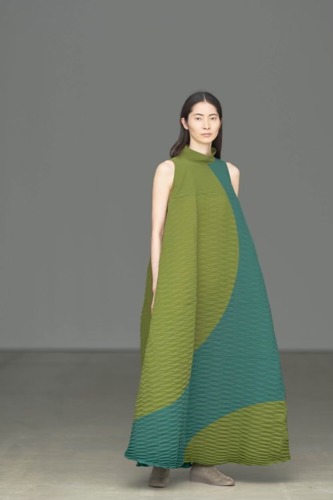
Designer photo courtesy Idlewild Woman
This fall, Cincinnati’s Idlewild became the first boutique to bring selections from distinctive and celebrated fashion designer Issey Miyake’s newest runway collection to a physical space anywhere in the region. To mark the occasion, the Idlewild team visited the Fashion Arts and Textiles archive at the museum, which is home to a collection of Miyake garments dating back to the mid-1980s, for a tour with Chief Curator and Curator of Fashion Arts and Textiles Cynthia Amnéus.
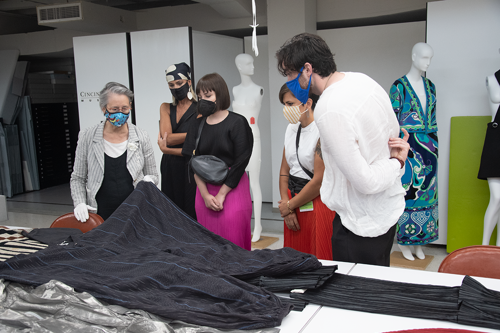
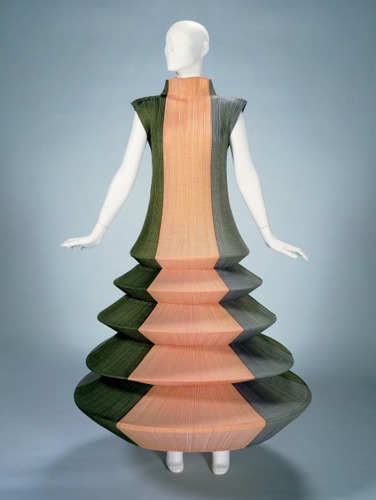
Issey Miyake (Japanese, b.1938), Minaret Dress, 1995, polyester, Gift of Miyake Design Studio in memory of Otto Charles Thieme, 1997.6.
“Miyake’s design perspective carries soulful weight. A seer of sorts, his approach to fashion blended the Eastern and Western mindsets, the former based on the principles of fabric and the latter centered on the body as the foundation for clothing,” wrote Idlewild stylist Nash Hill. “Throughout Miyake’s 50-year career he’s continued to push the technological boundaries of fashion and investigate clothing’s relationship with the human form, abiding by his famous mantra, ‘Design is not for philosophy, but for life.’
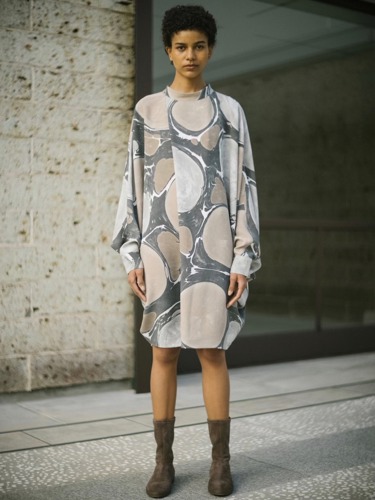
Designer photo courtesy Idlewild Woman
In the most recent fall collection, with some pieces available at Idlewild, Miyake’s brand looked towards the “integration of nature,” and the augmentation of its elements “through the technology, the idea, and the ingenuity,” as described by the house’s current designer, Satoshi Kondo,” wrote Hill.
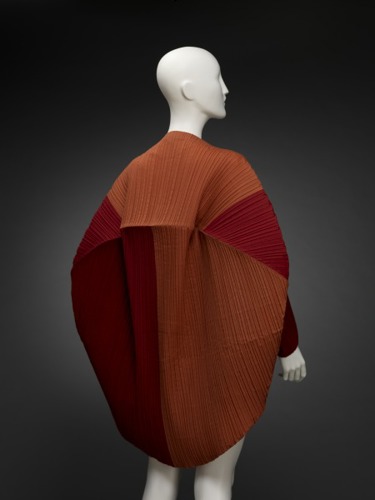
Issey Miyake (Japanese, b.1938), Rhythm Pleats Dress, 1990, polyester, linen, Museum Purchase with funds provided by Friends of Fashion, 2007.109.
[During the visit], our group circled around a large table upon which laid about seven or eight garments. An all-black ensemble from 1989 featured some of his earliest pleated work, the jacket and pants pieced together in an almost medieval armor-like fashion. A nylon jacket in a muted shade of saffron from 1996 wore sleeves with protruding forms of a deep crimson, accompanied by a heightened collar that altogether looked appropriate for a venture into space. Perhaps the garment most emblematic of Miyake’s ethos as a designer was from 1990, named the “Rhythm Pleats Dress.” Laid flat, the dress is a perfect circle with the only identifiable features being a neck hole and two sleeves. Subjected to gravity, the shape falls into a perfectly wearable evening garment.”
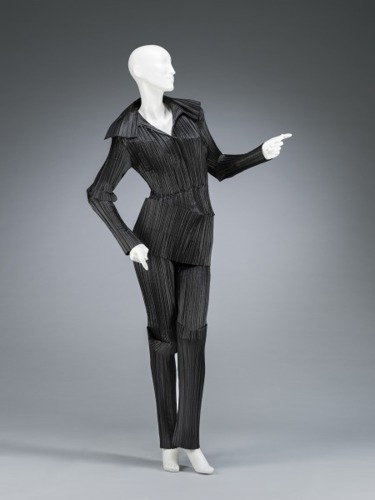
Issey Miyake (Japanese, b.1938), Ensemble: Top and Pants, polyester, Museum Purchase: Bequest of Fanny Bryce Lehmer, by exchange, 1990.17a-b
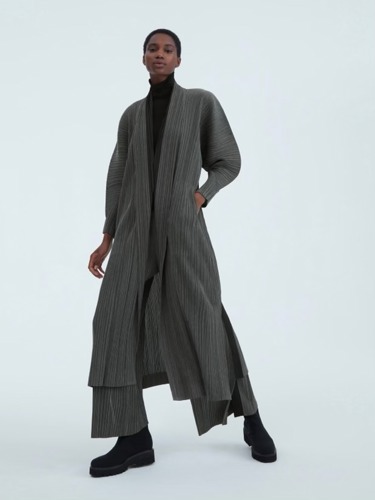
Designer photo courtesy Idlewild Woman
Visit the Idlewild Journal to read the full field report and learn even more about the designer’s history and newest collection.
Cincinnati, OH 45202
Toll Free: 1 (877) 472-4226
Museum Hours
Museum Shop
Terrace Café
Library
The Cincinnati Art Museum is supported by the generosity of tens of thousands of contributors to the ArtsWave Community Campaign, the region's primary source for arts funding.

Free general admission to the Cincinnati Art Museum is made possible by a gift from the Rosenthal Family Foundation. Exhibition pricing may vary. Parking at the Cincinnati Art Museum is free.
Generous support for our extended Thursday hours is provided by Art Bridges Foundation’s Access for All program.

General operating support provided by:



